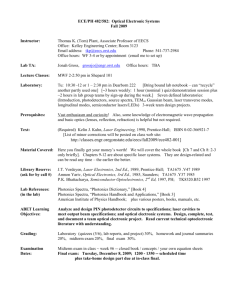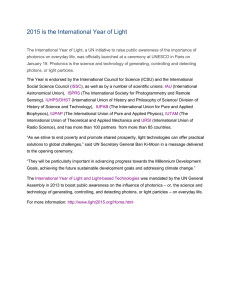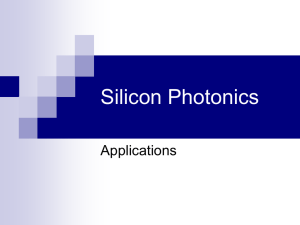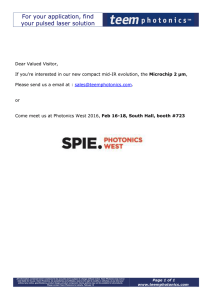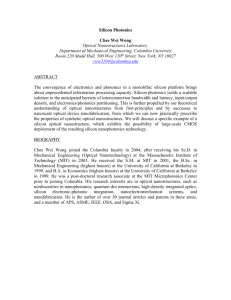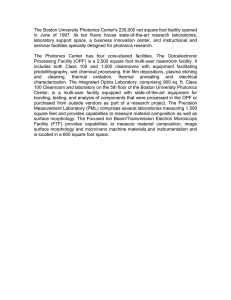A view on the Silicon Photonics trends and Market prospective
advertisement
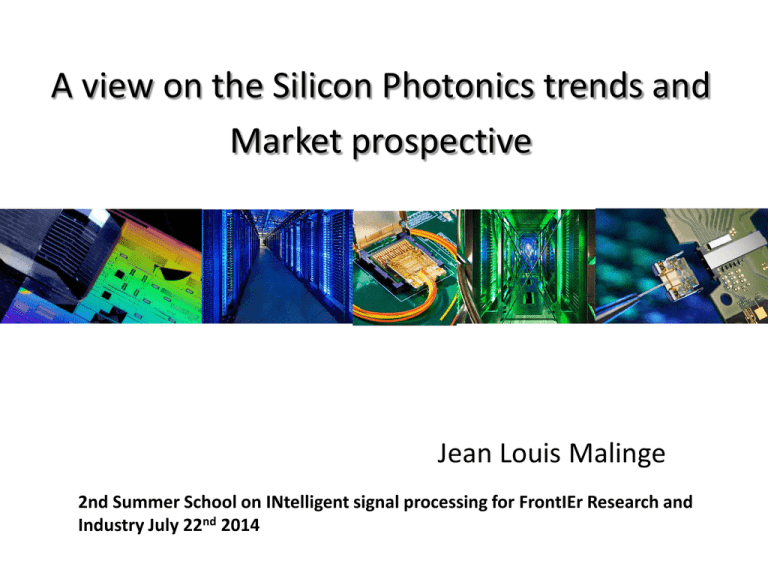
A view on the Silicon Photonics trends and Market prospective Jean Louis Malinge 2nd Summer School on INtelligent signal processing for FrontIEr Research and Industry July 22nd 2014 Outline Introduction What do we call Silicon Photonics The need for Silicon Photonics/Photonics Silicon Photonics-the ecosystem (players-supply chain) Silicon photonics-the early commercial products What’s next? Roadmap and conclusion Introduction My objective is to give you a broad overview of the Silicon Photonics trends and Market/application prospective Although the Silicon Photonics platform has been pioneered for 25 years this is still a technology in its infancy with a broad worldwide academic effort, numerous start-ups founded around the world and large corporations spending large R&D budget. This presentation was built from my experience as CEO of Kotura in California which I recently sold to Mellanox technologies www.mellanox.com and a contribution done in the last few months to a market analysis published by Yole Development www.yole.fr – www.i-micronews.com What do we call Silicon Photonics ? Silicon is widely used in optics and photonics 100 Silicon Photo Response Opaque region Transparent region Detecting Imaging 0 200 Kotura Company Proprietary 600 1,000 Wavelength [nm] Transmitting Modulating Switching Filtering Detecting Emitting Amplifying 1,400 Building blocks overview BRICK LASER - LIGHT SOURCE MODULATOR MODULATOR DRIVER TYPE MAIN CHARACTERISTICS Hybrid Main approach today : III-V laser dies are bonded on a Si receiver die with 2 different approaches: Laser is integrated in a small bloc with the isolator and the coupling lens and then bonded to the Si die: main solution today used by Luxtera or Lightwire Laser die is flip chip bonded on the Si receiver: coupling guide, no isolator required: solution used by Kotura Monolithic Light source is processed on SOI – but Si does not emit light - still basic R&D (2012) Off-chip Use coupled external laser - multiple wavelengths, power / thermal management is independent but needs complex packaging / couplers / fiber attach EAM (“Electro Absorption Modulators”) Strong effect with both hybrid / monolithic approaches possible Phase modulators External modulator – electro refraction is not mature (2012) while free carrier concentration variation modulation is the most effective mechanism today MZI Mach-Zehnder Interferometer is commonly used but has high power consumption (>1pJ/bit) and is quite a long structure Resonators Micro ring is still in R&D stage (HP main focus) – small size (down to 3µm), high speed (up to 30 Gb/s) and low power is possible ASIC Very complex analogic circuit (with few design players worldwide). 3 possible technologies depending on the signal power (CMOS, SiGe or III/V). Can thus be integrated on the transceiver substrate or as a separate die. Attached Mature but low integration density, expensive (considered for chip-level photonics with IBM Holey Optochip for example) Hybrid III-V dies/wafers are bonded – no alignment, high density but not fully integrated Monolithic Main approach today: Ge on SOI processed detectors. Si photo detectors (use of crystal defects, deposited polySi in µring resonators) are emerging as well. Large range of technologies possible. Grating Used by Kotura AWG Most popular in Telecom Ring resonator Can be used for both Mux/Demux but manufacturing is challenging and ring resonator is very sensitive to thermal variations Evanescent, grating, inverted taper etc … Allows fiber-to-chip or intra-chip coupling. Gratings on Si are today mostly used. DETECTOR MULTIPLEXER - MUX & DEMUX COUPLERS OTHERS Waveguides, splitters, Trans Impedance Amplifier (TIA)… SOI is well suited for waveguide because of high difference in refractive index. Different technologies: Rib/ridge WG, Strip/Wire WG, photonic crystal WG, Slot WG Different waveguide dimensions/technologies: 3 µm x 3µm with Kotura. Bigger waveguide meaning higher signal power handled. Interesting approach for transceivers. Electronic and Optics functions are independent, need for bonding or via technology to connect both. 0.4 µm x 0.4 µm by Luxtera. Historically for better electronic & photonic integration and easier manufacturing From Building Blocks to a Complete Platform 3um 0 FK Modulator3um -5 World class WDM with <2dB insertion loss, 0.5dB PDL and <30dB X-talk floor Loss(dB) -10 -15 -20 -25 -30 -35 30GHz demonstrated Potential: 40Gb/s at 3V -40 3um Ge PD running at >40Gb/s,1.1A/W sensitivity and <1uA dark current TE TM 1520 1540 1560 1580 Wavelength(nm) 1600 Gain element 3um Monitor Photodiode Rib waveguide grating 3um ~ 200nm Power Monitors Lasers Ge Detectors 0 4 3 2 Demonstrated DFB like external cavity laser in Si platform 1 1 0.8 2 0.6 0.4 0 0 50 100 150 7 1 -0.0V: 3dB BW 17.5GHz -1.0V: 3dB BW 32.6GHz -3.0V: 3dB BW 36.8GHz -3 -6 0 -1 0.2 Drive current (mA) Response(dB) 5 3um Responsivity(A/W) 6 1.2 PDR(dB) Power in waveguide (mW) 7 200 - 1000 µm TE TM Limit -2 1300 1400 1500 1600 Wavelength(nm) 1300 1350 1400 1450 1500 1550 1600 Wavelength(nm) -9 3dB Bandwidth(GHz) 8 0 VOA 3um 40 30 20 10 0 8 10 1 2 Voltage(V) 3 9 10 Frequncy(Hz) 10 10 strictly private and confidential The Need for Photonics: Root Cause The information explosion. We Created: • 5 EB by 2000, ~500EB by 2009 & 2500 EB / year by 2012 • Use of internet for entertainment and broadcasting on demand Rapid growth in internet traffic is driving growth in computation and communication of information. Huge challenges on processing, transmission and storage 2dB/Y of demand met by 1dB/Y growth 1Pb/s 1000 Huge challenges to Moore’s Law Dominance of power and energy! Two special years 1Tb/s 100 SpecInt2000 Convergence of Computing and Communication 2dB/Y 1Gb/s Date of Introduction 10 1993 1999 2005 1990 2000 2010 What’s happening during 1 Internet minute Battle between Optics and Copper Latency Bandwidth Power dissipation Electromagnetic interference Signal integrity Optics has progressively eliminated copper in the metro and long haul network in the last 20 years and will continue its migration all the way to chip to chip application in the next 20 years Silicon for Photonics components: the good and the not so good!! • • • • • • • • Transparent in 1.3-1.6 µm region CMOS compatibility Low cost High-index contrast – small footprint − High index contrast –waveguide loss − No detection in 1.3-1.6 µm region (in bulk Si) − No linear electro-optic effect − No efficient light emission Supply chain: the ecosystem? Acquired by R&D/ Development Stage Product Manufacturing Si Photonics Activity (2014) R&D/MPW Design Fabless Foundries Business model Devices / modules Systems End-users The Si Photonic supply chain Optical interconnects firms Chip firms Suppliers Servers End-users Materials & supplies etc … attach, optical test, final test) Assembly (2.5D assembly, fiber/light source etc … Wafer probe: optical & electrical sort etc … Wafer fab (CMOS & light source) Manufacturing equipment Design Wafers v etc … etc … Today, end-users are driving the R&D for optical data centers. etc … etc … More than $1B invested worldwide by public fundings ! • Strong investment from the European Commission In the period 2002–2006, around 50 photonics research projects were funded under the EU’s 6th research framework program (FP6) for approximately €130 million. Since the beginning of FP7, 65 R&D photonic projects, including organic photonics, have been selected so far with more than €300 million of EU funding. A total of €430 million invested by the European Commission e.g. US$ 580M • Japan : JISSO program $300M invested in 10 years • US : mainly DARPA programs A $44M DARPA program involving Kotura, Oracle, Luxtera, various Universities (Stanford, San Diego) Orion also has a big program Almost $1B transactions for photonics in datacenter! Company Lightwire (US) Date February 2010 Transaction value Product Silicon CMOS optoelectronics interconnects / optical transceivers. US$271M US$20M Acquirer Rationale for transaction Cisco (US) To face with increasing traffic in data centers / service providers Molex (US) Luxtera may be changing strategy to become an IP licensing company. Molex had AOC product line for 12channel AOCs with a product from Furukawa/Fitel based on a 1060nm InGaAs VCSEL. TeraXion (CAN) To access 100Gb InP modulator technology. Avago (US) To strengthen products portfolio for 40Gb & 100Gb data centers applications. Luxtera AOC line (US) January 2011 AOC line COGO Optronics (CAN) March 2013 InP modulators & lasers. Cyoptics (US) April 2013 InP-based photonic components. Kotura (US) May 2013 Si photonics & VOAs for data center. $82M Mellanox (US) To access 100Gb optical engine for data centers. IPTronics (US) June 2013 IC for parallel optical interconnects (drivers). $47M Mellanox (US) To access products / technologies for 100Gb optical engine. Caliopa (BE) September 2013 Si-based optical transceivers for datacoms. $20M Huawei (CHINA) To develop European-based R&D in Si photonics. Est. < $30M US$400M TOTAL: ~US$900M Est. 2013 Market < US$30M Silicon photonics 2013-2014 market forecast in US$M SiPh Total Market (US$M) $800 $700 $600 US$M $500 $400 $300 $200 $100 $0 SiPh Total Market (US$M) • 2013 2014 2015 2016 2017 2018 2019 2020 2021 2022 2023 2024 CAGR $23 $29 $39 $46 $52 $122 $188 $330 $444 $535 $612 $720 38% Silicon photonics devices market will grow from less than US$25M in 2013 to more than US$700M in 2024 with a 38% CAGR. – Emerging optical data centers from big Internet companies (Google, Facebook …) will be triggering the market growth in 2018 (see following slides). © 2014• 18 A broad range of application Gyro, RF etc Transceivers Defense Data Com Active Cables Lab on Chip High BW Cabling Bio/Medical and Life Sciences Interrogation engines Interconnect On Board Optical Engines Sensor applications Home wiring and Consumer Applications In-cabinet communication Kotura products 4x25G QSFP Parallel Link Current: ~1.5W Next gen: 0.8W Assuming no CDR SMF low jitter 4x25G Parallel in QSFP Differential Rx Eye at 25Gb Reach independent SR transceiver or AOC solution Tx Reliable Edge emitters 100m Strictly Private and Confidential Rx 100GbE (4x25G) WDM in QSFP Power Monitors Lasers Ge PD Rx Tx Modulators Mux 25G Transmit eye with low power drivers from Oracle (<70mW/ch) Laser spectrum 22 Confidential and Proprietary DeMux Ge PD bank 25G received eye over 2Km of fiber Modulators Laser bank Molex’ AOC with Luxtera Si Photonic Die Fiber coupling Evolution of optical interconnect Summary Clear need/technology gap created by the explosive growth of Data/image communication Photonics /Silicon Photonics will be the platform of choice for interconnect resolving the major current technological issues: latency, bandwidth, power dissipation and signal integrity. A world wide ecosystem has developed over the last 10 years to generate the supply chain This is still a market in its infancy with challenges to be resolved: laser integration, low cost integration/ packaging/ standardization….
